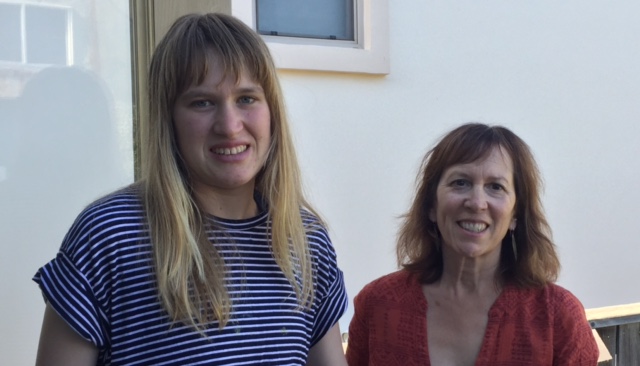Several months prior to this I had gotten a small head start by touring a residential and adult day program, in a bucolic setting among redwoods, hills and the quaint downtown streets of Marin County.
The feeling I got upon walking through the door was happiness and inclusion. A music session was winding down and most participants were engaged. Several art classes were also going on concurrently, and that was just the beginning. A textile art center was abuzz with some 30 people busy at their looms, while another group was outdoors working on the nearby garden. A residential hall and six group homes were scattered about in neighboring towns where most of the clients live. "OK," I thought. "This is a program I could see my Briana in. How do I sign her up?"
Not so easy. There is not even a waiting list per se, and the program prefers clients that are more independent than Briana. She still needs help sometimes in the bathroom, and she needs a pair of eyeballs on her at all times due to her wandering tendencies. There really was no space for someone with such great needs.
So what else was out there? I began the search again, this time out of urgency due to Briana’s impending loss of school placement. Our social worker at the regional center, a state-funded agency that serves people with disabilities, loosely explained the structure of existing programs. There are behavioral programs in which staff members are trained to deal with severe behaviors, such as wandering, self-injury, aggression, and toileting needs. The staff-to-client ratios in these behavioral programs start at 1:3 – one staff person for every three clients — and if needed can be moved up to 1:2 and even 1:1. In other words clients first have to try the 1:3 and fail, 1:2 and fail to get a 1:1 -- instead of just asking for the 1:1 to begin with. The program I saw in Marin was non-behavioral, so the ratio is more like 1:6.
My daughter’s social worker set up more tours, and I dutifully went to each one. The first one, another non-behavioral program, was quite the opposite of the Marin program. I saw 50-plus clients crowded into two run-down rooms, many in wheelchairs parked in front of a big-screen television. It was noisy and chaotic. There were some smiles, but I didn’t picture Briana there at all.
I asked the director how often the clients went out in the community. He said once a week and with special arrangements by parents if they wanted activities like swimming.
I couldn’t wait to get out of there, but the following two programs, which were behavioral, were not much better. They had greater staff-to-client ratio, but the clients almost never left the building. There was no outdoor space to utilize or enjoy.
Briana is outdoorsy, energetic, enthusiastic and for the most part happy. She has her down days just like all of us, but I want her to access the most the community has to offer. I was overwhelmed by a sense of sadness that felt like an open wound for months.
These programs, with some exceptions like the well-established one in Marin, are buckling under current conditions, and they are only going to get worse with the increasing number of adults like my daughter about to age out of the school setting.
The demand is leading some new programs to open, but they are faced with trying to operate a business without failing. This can mean sub-optimal buildings, and paying low wages to staff.
The ratios of staff members to clients are controlled by reimbursement rates by the regional centers. The regional centers receive funding from the state Department of Developmental Services. The pay rates of some of these professionals are on par with what caregivers are paid, which is close to minimum wage. Pet sitters or baristas that serve us our coffee may earn more than we pay those important, compassionate people that care for our loved ones. Are we OK with this?
Time is needed to find a good day program for a disabled young adult because there are not enough options. In the next decade, 500,000 children with developmental delays will enter adulthood nationwide, overwhelming a system that is already inadequate for the current numbers. Legislative leaders need to know how bad the problem already is so that plans can be made to avoid this looming public crisis.
